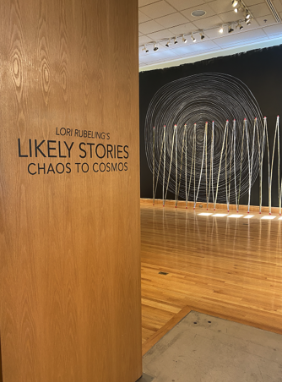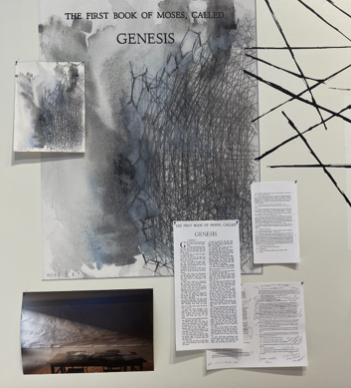By: Jasmine Méndez-Paredes
It’s golden hour on the Greenspring campus. Stevenson faculty are carefully placing refreshments on a table outside the art gallery moments before people start trickling in. The audience gathers and begins chattering in a nonchalant fashion until the moment they’ve waited for finally arrives. Graphic Design professor, Lori Rubeling, unveils her new art exhibition, Likely Stories: chaos to cosmos.
About the Exhibit
Ms. Rubeling’s goal, as stated in her own materials, was to “present climate crisis concepts that allow for the body, mind, and spirit to receive and interpret climate change information.” Rubeling said the term “likely stories” symbolizes the knowledge accumulated through experiences while “chaos to cosmos” refers to a state of understanding and being. She imagines herself a Pre-Socratic philosopher who desires to impact our understanding of the climate crisis.
“We’re emerging in tremendous climate disruption,” Rubeling said. “If we can approach this disruption as play as we are part of it, we would be much better off than being fearful.”

A Walk Through the Gallery
The audience catches a first glimpse of the vivid wallpaper, a hypertext collage, and a wall filled with numerous white rings layered with bamboo poles. Rubeling’s artwork initiates the conversation communicating various themes such as climate wellness, sustainability, order, perception, and memory.
As a result, the art gallery morphs itself into a room of discourse among peers. Rubeling elaborates that her work evolves into, “touchpoints to have a conversation around [so that we may gain a] shared understanding… in order to change our behavior.”
Rubeling also emphasizes that the exhibition should be viewed as an experience rather than a showcase, “This is what I’m asking everyone: How is your body affected by being in the space?”
Some of Rubeling’s notable works, The Sequoia Ruler and Straw cross-cut diagram, are inspired by her trip to California’s Sequoia and Kings Canyon National Park back in 2018. In an interview, Rubeling compared her experience in creating these works like Pre-Socratic philosopher Anaximander who found a way to represent the patterns of the sky on earth by creating a map.
“Like the Pre-Socratics, I am representing my direct observation into 3-dimensional objects so that my experiences become shareable,” Rubeling wrote.
The Sequoia Ruler depicts multiple white circular figures which represent the tree’s growth rings. Not to mention, Rubeling states the bamboo ruler is, “a collapsed representation of the actual height of ‘General Sherman’ a 2,000-year-old sequoia tree.”
The Straw cross-cut diagram depicts an imagined height of a giant sequoia with 279-foot height (right) and Baltimore’s shot tower in comparison (left).
Rubeling explains her strategy in giving the audience a point of reference to understand the sequoia tree, “On the East Coast (of the United States), we rarely encounter tall trees. Baltimore’s Shot Tower at 240-feet is the closest object to comparison.”
Taking us through the Curating Process
Like many artists, all of Rubeling’s thinking begins in her sketchbook. Rubeling recollects her past experiences, recent artworks, decades of study, and other inspirational sources to come up with a theme and the materials she’d like to use. That work translates into 5 months of planning, research, and configuring the physical space she is working in. “I always think about exhibitions as installations,” Rubeling said.
“I’m not just hanging up work. It’s a space I’m going to fill.” — Lori Rubeling
After bodies of research and planning, Rubeling and her team gather the materials for a summer’s worth of work. “I had to harvest the bamboo… [which] takes 12 weeks to cure, the wallpaper got printed, and I had… [a team of research] assistants and co-curators… [who created the] hypertext wall,” she said.
The diverse media used for this exhibition brought some challenges for the installation. “Originally [the infinity drawings were] going to be on canvas and we were going to staple it… [but] facilities… tell us] ‘No, that’s too many holes.’ Sometimes those kinds of conversations have to happen.” Despite the impediment, the artist was satisfied with the outcome and even gained permission to paint the wall black for The Sequoia Ruler.

Student Experiences from the Exhibition
Junior Graphic Design major Angel Rutter, who is one of Rubeling’s research assistants described her experience with the exhibition as an intellectual exercise. “It makes you think on a deeper level,” Rutter said. “Of course, seeing it it’s very pretty and unique but it makes you think about how it relates to you, how it relates to other people, and how it relates to the environment.”
Rutter was hired as an exhibitions assistant her freshman year after taking a Fundamentals of Design course with Rubeling.
Another research assistant is sophomore film major, Tana Marshall. She explains the team’s process in co-curating the hypertext wall, “It was very sporadic,” she said. “In the beginning we… had a bunch of things to work with… we had cut things down and figured out what was more important. It took a lot of planning and behind-the-scenes work to put it into order.”
The exhibition will remain open in the Greenspring Art Gallery until the end of the semester. There will be several events based on Rubeling’s exhibition. A Society of Design Arts webinar will be held on October 26th, Fiction Writing Readings on November 1st, and a Performance Reception on November 7th for the Theater Media and Performance production As You Like It.

























































